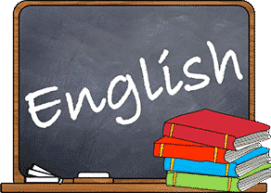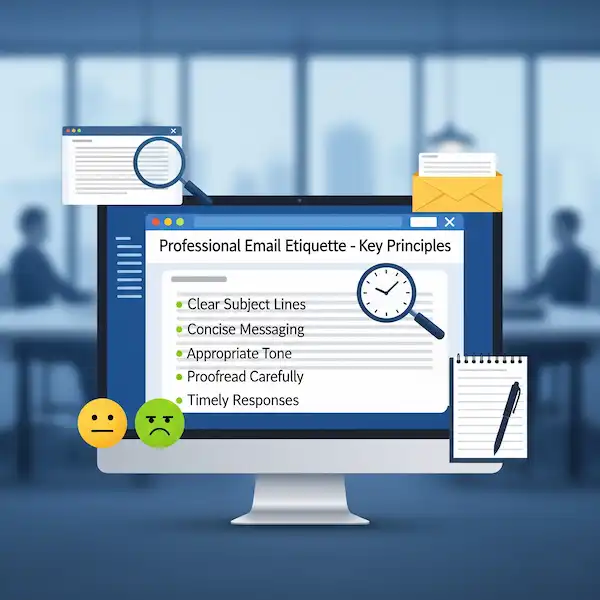Master Your Inbox: Business Email Etiquette for Business Success! 📧
In the business world, email is king! Knowing how to write professional emails is super important for your career. This guide will help you, even if you’re still learning English, to master the art of business email etiquette. Let’s dive in!
1. The Perfect Email Structure: Your Blueprint for Success
Think of your email like a mini-letter. It needs a clear structure so your message is easy to understand.
A. The Subject Line: Your Email’s Headline! 📝
The subject line is the very first thing someone sees. It should be short, clear, and tell the reader what the email is about.
| Good Subject Lines | Bad Subject Lines | Why? |
| Meeting Request: Project A | Hello! | Too vague. |
| Urgent: Invoice #1234 Due | Important | Still too vague, not specific. |
| Question about Report X | Can we talk? | Not professional enough. |
| Follow-up: Our Call Today | Fwd: Fwd: Re: Fwd: document | Looks messy and confusing. |
Pro-Tip: If you’re replying, you can keep the “Re:” but add more detail if needed. For example, “Re: Project A – Your Question.”
B. The Salutation: Hello, Who Are You Talking To? 👋
This is how you greet the person. Your relationship with the person dictates the level of formality.
| Formality | Example | When to Use |
| Formal | Dear Mr. Smith, <br> Dear Ms. Lee, <br> Dear Professor Kim, <br> Dear Sir or Madam, (if you don’t know the name) | First contact, senior colleagues, external partners, formal situations. |
| Semi-Formal | Dear John, <br> Hi Sarah, | Colleagues you know well, people you’ve met before. |
| Informal | Hi Alex, <br> Hello there, | Close colleagues, casual internal communication (use with caution). |
E-A-A-T Tip: Always start with a formal salutation for new contacts, especially in professional cultures where respect is highly valued.
C. The Body: Your Message! ✍️
This is where you write your main message.
- Be Clear: What do you want to say?
- Be Concise: Don’t use too many words. Get straight to the point.
- Be Organized: Use short paragraphs or bullet points to make it easy to read.
Example:
Dear Mr. Sok,
I hope this email finds you well.
I am writing to inquire about the upcoming training session for new employees. Could you please confirm the date, time, and location?
Additionally, I would appreciate it if you could share the agenda for the session.
Thank you for your time.
D. The Closing: Saying Goodbye Politely 👋
Just like the salutation, your closing depends on how formal you need to be.
| Formality | Example | When to Use |
| Formal | Sincerely, <br> Regards, <br> Best regards, <br> Yours faithfully, (if you used “Dear Sir or Madam”) | Formal situations, first contact. |
| Semi-Formal | Best, <br> Thanks, <br> Many thanks, | Colleagues you know. |
| Informal | Cheers, <br> Talk soon, | Close colleagues (use with caution). |
E. The Signature: Who Are You? ✒️
Your signature tells people who you are and how to contact you.
Essential Information:
- Your Full Name
- Your Job Title
- Company Name
- Contact Information (Phone, Email, Website – optional)
Example:
Sincerely,
- Sopheak Kim Marketing Assistant
- ABC Innovations Co., Ltd.
- +1 (555) 123-4567
- www.abcinnovations.com
2. Writing a Clear and Concise Email Message 🎯
Imagine your reader is busy (they probably are!). They don’t have time to read long, rambling emails.
- One Idea Per Paragraph: If you have multiple points, separate them into different paragraphs.
- Use Simple Language: Avoid jargon or complex sentences.
- Proofread! Always check for spelling and grammar mistakes. It makes you look professional.
Before you send: Read your email out loud. Does it make sense? Is it easy to follow?
3. Using Appropriate Tone and Language in a Business Email 🗣️
Tone is how your email “sounds” to the reader. In business, you generally want to sound professional, respectful, and helpful.
- Avoid Emojis & Slang: In most business emails, emojis like 😂 or slang like “LOL” are not appropriate.
- Be Polite: Always use “please” and “thank you.”
- Avoid All Caps: WRITING IN ALL CAPS LOOKS LIKE YOU ARE SHOUTING!
- Be Positive: Even if you have a problem, try to frame it positively.
Example of Tone:
| Bad Tone | Good Tone | Why? |
| I need that report now! | Could you please send the report by EOD? | Demanding vs. Polite request. |
| You made a mistake. | There seems to be an error in the report. Could we review it together? | Accusatory vs. Collaborative. |
| Why didn’t you reply to my email? | I’m following up on my previous email from [Date]. | Impatient vs. Professional reminder. |
E-A-A-T Tip: Always be extra polite and formal when communicating with superiors or external clients. Building strong, respectful relationships is key.
4. Attaching Documents and Replying to Emails 📎
These seem simple, but there are a few important rules.
A. Attaching Documents 📄
- Mention the Attachment: Always write a sentence in your email body saying you’ve attached something.
- “Please find the report attached.”
- “I have attached the meeting minutes for your review.”
- “The updated proposal is attached for your consideration.”
- Check the File Size: Large files can cause problems. If it’s too big, consider using a cloud storage link (like Google Drive or Dropbox).
- Name Files Clearly: Don’t name your file “document1.docx”. Name it something like “Project A Proposal_YourName_Date.pdf”.
Common Mistake: Forgetting to attach the document! Always double-check before hitting send.
B. Replying to Emails ↩️
- Reply All? Be Careful! Only use “Reply All” if EVERYONE on the original email needs to see your response. Sometimes, a “Reply” (to just the sender) is enough.
- Be Timely: Try to reply to business emails within 24-48 hours. If you need more time, send a quick email saying, “Thank you for your email. I will get back to you by [Date].”
- Keep the Thread: Don’t delete the previous messages in the email chain. This helps everyone remember the context.
- Change Subject if Needed: If the conversation changes topics, update the subject line to reflect the new discussion.
E-A-A-T Tip: Prompt replies show efficiency and respect for others’ time.
Additional Helpful Content for English Students 💡
- Phrases for Requests:
- “Could you please…?”
- “Would it be possible to…?”
- “I would appreciate it if you could…”
- Phrases for Information:
- “I am writing to inquire about…”
- “Could you provide more details on…?”
- “I would like to know if…”
- Phrases for Apologies:
- “Please accept my apologies for…”
- “I apologize for the delay.”
- Phrases for Confirmations:
- “I confirm that…”
- “Please confirm your availability.”
Additional Links
External Links for Authoritative Sources 🌐
- Purdue OWL (Online Writing Lab): A fantastic resource for all kinds of writing, including professional email. https://owl.purdue.edu/owl/general_writing/e_mail_etiquette/index.html
- Indeed Career Guide – Email Etiquette: Practical tips for business professionals. https://www.indeed.com/career-advice/starting-new-job/email-etiquette
By following these guidelines, you’ll be writing professional, clear, and effective business emails in no time! Keep practicing, and your communication skills will shine. Good luck! ✨

